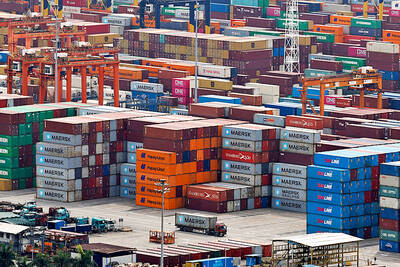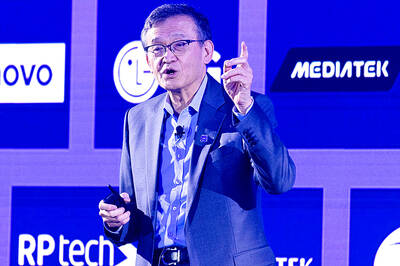Shares of liquid-crystal-display (LCD) makers such as LG.Philips LCD Co extended declines on concern the companies will have to set aside money because of an antitrust probe in the US$69 billion industry.
LG.Philips and Taiwan's AU Optronics Corp (友達光電), already beset by sliding screen prices, fell for a second day after authorities in the US, Europe, Japan and South Korea began investigating LCD makers for alleged price fixing. Any penalties would squeeze profits, analysts said.
Akinori Yamada, a director of management and planning at Japan's Fair Trade Commission, said yesterday that the probe was related to price fixing.
"Companies will have to start setting aside provisions for the potential fines," said Jeff Kim, an analyst at Hyundai Securities Co in Seoul. "Cash flow and earnings may be negatively affected once they start paying the penalties."
Kim has a "neutral" rating on the LCD industry.
The probe is the first in an industry that has grown 14 percent this year as consumers increasingly choose flat-screen televisions and computer monitors. Prices for a 40-inch LCD TV may fall 38 percent this quarter from a year earlier, research company DisplaySearch said.
LG.Philips, the world's second-largest LCD maker, fell 1.2 percent to close at a record 25,550 won (US$27.69) in Seoul, after sliding 4.3 percent yesterday. AU Optronics, the third biggest, dropped 1.2 percent to NT$42.10 (US$1.29). Sharp Corp, Japan's largest maker of LCD televisions, fell 1.5 percent to ?2,040 (US$17.43).
Samsung Electronics Co, the world's largest LCD maker, gained 0.3 percent. The company generates more than 90 percent of its operating profit from products other than LCDs, including semiconductors and electronics.
A four-year US probe into price fixing in the computer-memory chip market resulted in four companies, including Samsung Electronics, and 16 individuals being fined US$731 million.
Regulators and company executives didn't specify a timeframe for the LCD probe.
Chi Mei Optoelectronics Corp (
"Our subsidiaries in Japan and the US informed us earlier this week that they were requested by local regulators to provide information for the antitrust investigation on the sale of panels," Denis Chen (陳世賢), director of the finance and accounting department at Tainan-based Chi Mei, said by phone yesterday.
Chen declined to provide details on the probe.
Taiwan's Fair Trade Commission said yesterday that it would watch the development of the probe closely and investigate local LCD makers should there be evidence showing that they were involved in violation of the Fair Trade Act (
In a statement released yesterday, the commission said it had not received a request to assist in the probe, and that there was no evidence indicating that Taiwanese LCD makers had engaged in such activities.
Panel prices reported by the makers have been sliding over a period of time, indicating there was benign competition in the industry, the commission said.
According to DisplaySearch, the average price of a 40-inch LCD TV will decline 38 percent to US$1,889 this quarter from US$3,054 a year earlier. The cost of the same TV will fall to US$984 by 2009, the research company said.
Additional reporting by Jessie Ho

The Eurovision Song Contest has seen a surge in punter interest at the bookmakers, becoming a major betting event, experts said ahead of last night’s giant glamfest in Basel. “Eurovision has quietly become one of the biggest betting events of the year,” said Tomi Huttunen, senior manager of the Online Computer Finland (OCS) betting and casino platform. Betting sites have long been used to gauge which way voters might be leaning ahead of the world’s biggest televised live music event. However, bookmakers highlight a huge increase in engagement in recent years — and this year in particular. “We’ve already passed 2023’s total activity and

Nvidia Corp CEO Jensen Huang (黃仁勳) today announced that his company has selected "Beitou Shilin" in Taipei for its new Taiwan office, called Nvidia Constellation, putting an end to months of speculation. Industry sources have said that the tech giant has been eyeing the Beitou Shilin Science Park as the site of its new overseas headquarters, and speculated that the new headquarters would be built on two plots of land designated as "T17" and "T18," which span 3.89 hectares in the park. "I think it's time for us to reveal one of the largest products we've ever built," Huang said near the

China yesterday announced anti-dumping duties as high as 74.9 percent on imports of polyoxymethylene (POM) copolymers, a type of engineering plastic, from Taiwan, the US, the EU and Japan. The Chinese Ministry of Commerce’s findings conclude a probe launched in May last year, shortly after the US sharply increased tariffs on Chinese electric vehicles, computer chips and other imports. POM copolymers can partially replace metals such as copper and zinc, and have various applications, including in auto parts, electronics and medical equipment, the Chinese ministry has said. In January, it said initial investigations had determined that dumping was taking place, and implemented preliminary

Intel Corp yesterday reinforced its determination to strengthen its partnerships with Taiwan’s ecosystem partners including original-electronic-manufacturing (OEM) companies such as Hon Hai Precision Industry Co (鴻海精密) and chipmaker United Microelectronics Corp (UMC, 聯電). “Tonight marks a new beginning. We renew our new partnership with Taiwan ecosystem,” Intel new chief executive officer Tan Lip-bu (陳立武) said at a dinner with representatives from the company’s local partners, celebrating the 40th anniversary of the US chip giant’s presence in Taiwan. Tan took the reins at Intel six weeks ago aiming to reform the chipmaker and revive its past glory. This is the first time Tan